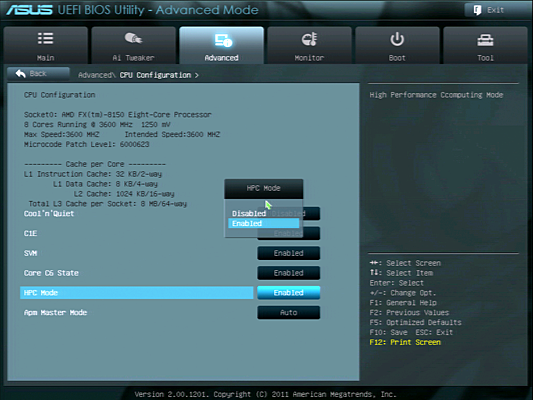AMD's FX-8150 After Two Windows 7 Hotfixes And UEFI Updates
Introducing a new processor architecture takes a colossal effort. AMD's modular Bulldozer design ran into its share of resistance at launch. Can a handful of software updates turn the company's flagship FX-8150 into the powerhouse AMD promised?
Scheduling, Core Parking, And Throttling, Oh My!
The fact that AMD’s Bulldozer architecture failed to set the PC world on fire is no secret (AMD Bulldozer Review: FX-8150 Gets Tested), its eight integer cores sharing the resources of a four-module design. AMD credits its effort with lower power consumption compared to a full eight-core design, and even showed off plenty of benchmarks at its press events to demonstrate that the performance of its configuration was truly competitive in the right tests. At the end of the day, though, we were left unimpressed with Bulldozer's position relative to the competition, even though we gave it a fighting chance in our System Builder Marathon, Dec. 2011: $1200 Enthusiast PC.
In our launch story, we made it very clear that Windows 7 is not optimized for the module-based layout that Bulldozer employs. Chris talked to representatives at Microsoft who were able to confirm the operating system's behavior, and he ran the developer build of Windows 8 to confirm the next-gen OS would handle the FX family differently. From that review:
"According to Arun Kishan, software design engineer at Microsoft, each module is currently detected as two cores that are scheduled equally. So, in a dual-threaded application, you might see one active module and three idle modules—great for optimizing power, but theoretically less ideal from a performance standpoint. This also plays havoc with AMD’s claim that, when only one thread is active, it has full access to shared resources. Adding just one additional thread could tie up those shared resources, even as multiple other modules sit idle.
Microsoft is looking to change that behavior moving forward, though. Arun says that the dual-core modules have performance characteristics more similar to SMT than physical cores, so the company is looking to detect and treat them the same as Hyper-Threading in the future. The implications there would be significant. Performance would unquestionably improve, while AMD’s efforts to spin down idle modules would be made less effective."
This explanation does make sense for certain workloads. Two threads running on two separate modules have access to two front ends (and two FPUs), while two cores running on a single module must share both the front-end and FPU. A smarter OS might know the most effective way of distributing the load, which AMD stated would be a feature of Windows 8. Fortunately, MS released a hotfix to address some of what was purportedly going wrong in Windows 7.
There remained, however, a performance penalty in the form of latency if the task that would have been scheduled to an already-active module is instead sent to a “parked” core. Microsoft introduced a second hotfix to address that issue. Put together, these two patches should help overcome the Bulldozer architecture's performance issues in lightly-threaded applications.
We followed up with Microsoft yet again for comment, and heard back that that the core scheduler indeed now recognizes AMD's modules as SMT sets. However, the Windows 7 patches still should not be taken as an indication of how FX will behave under Windows 8. Apparently, there will be additional scheduler improvements that relate to how SMT is treated.
Stay On the Cutting Edge: Get the Tom's Hardware Newsletter
Get Tom's Hardware's best news and in-depth reviews, straight to your inbox.

Although Microsoft helped AMD address how the Bulldozer architecture is addressed in less demanding workloads, there is still an issue we've seen on the FX-8150, where the 3.6 GHz part throttles down to 3.3 GHz under a full load. That’s probably considered a power-saving feature in densely-packed 2U servers. However, desktop users have the option to disable this strange step backward through the HPC Mode options exposed through recent firmware updates.
Our goal today is to find out how the latest ecosystem improvements help AMD's early-adopting customers. We're going to test with the benchmarks we normally run, too, and not the hand-picked titles AMD is using to illustrate the gains enabled by Microsoft's new patches.
Current page: Scheduling, Core Parking, And Throttling, Oh My!
Next Page Test Settings And Benchmarks-
azathoth Sigh* I was expecting to see small gains of maybe ~8% optimistically, but instead I see microscopic improvements.Reply
It is simply embarrassing for an eight core processor to be beaten by a quad core, even considering some apps don't support more then two or four cores. -
JonnyDough ReplyIn our own exploration of performance in the developer build, FX did, in fact, yield better numbers.
There it is. That's all you need to know. AMD made a processor that was too ahead of software to be viable. Forward thinking is good, but the software just wasn't ready for it. I have a feeling they'll be ahead though when it comes to the next architectural design. They are after all, pioneering the way. -
clownbaby Like putting lipstick on a pig. I don't understand the method behind AMD's madness with these chips. They're basically relying on software to take advantage of optimization instead of developing a truly fast and efficient architecture. More cores may be the way of the future, but AMD can't compete with intel if it's using twice as much silicon (or more) to achieve similar results. They're reputation as a value alternative can only hang around so long before consumers wake up. I sure hope their next chip takes a large step forward, if for no other reason than to keep intel CPUs affordable.Reply -
I still cant get past that the 8 core 8150 is slower then a quad core no hyper threading 2500k doing a 3DS Max Render. 248 frames, 8 at once on the 8150, 4 at once on the 2500k, but the 2500k actually finishes rendering each frames in under half the time it takes the 8150 to render a frame.Reply
That is just pathetic for an 8 core to fail at rendering. -
KelvinTy Sigh... The change is so insignificant that they don't even need to exist...Reply
My God, AMD... the 2500K just shhhh all over your face again... Why would you do such thing! -
soccerdocks stm1185I still cant get past that the 8 core 8150 is slower then a quad core no hyper threading 2500k doing a 3DS Max Render. 248 frames, 8 at once on the 8150, 4 at once on the 2500k, but the 2500k actually finishes rendering each frames in under half the time it takes the 8150 to render a frame. That is just pathetic for an 8 core to fail at rendering.Reply
Is rendering a floating point operation or integer operation? The 8150 is not truly an 8 core processor. Although it may perform like one in some aspects, it does not have 8 full cores. -
de5_Roy great read. too bad the patches didn't improve performance. hopefully win 8 will change it. by then, piledriver and trinity might become available.Reply
it was funny to see stock 2500k's superior capability (especially at 1080p) as a gaming cpu. i recently read in some thread - one guy claiming that 8150's 8 cores (2500k has only 4 cores) improve performance in cpu bound scenarios.
power consumption is still bad. if amd gets at least 10% better with win 8, that will mean 23 watts less! there's still hope there....i hope...
i wonder what will happen in multiplayer games e.g. bf3 where cpu is important. from starcraft figures, looks like stock 8150 won't be able to keep up with stock 2500k. -
_Pez_ hmm well if there are "8" cores divided in 4 modules . Then why not do multitasking on both AMD "Octa" and Intel quadcore "Hyper treaded CPU's" with multiple programs and see what numbers/time are droped out. Is think my idea could probably show something different.. let's keep giving a try to AMD's new architecture....Reply
